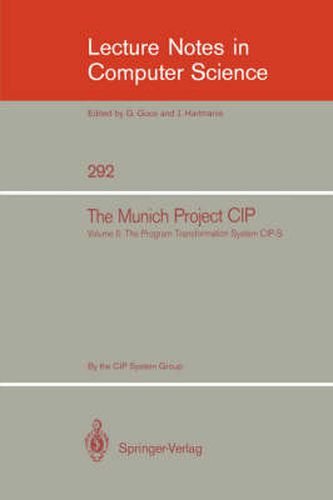Readings Newsletter
Become a Readings Member to make your shopping experience even easier.
Sign in or sign up for free!
You’re not far away from qualifying for FREE standard shipping within Australia
You’ve qualified for FREE standard shipping within Australia
The cart is loading…






This title is printed to order. This book may have been self-published. If so, we cannot guarantee the quality of the content. In the main most books will have gone through the editing process however some may not. We therefore suggest that you be aware of this before ordering this book. If in doubt check either the author or publisher’s details as we are unable to accept any returns unless they are faulty. Please contact us if you have any questions.
This book is the second of two volumes that present the main results which emerged from the project CIP - Computer-Aided, Intuition-Guided Programming - at the Technical University of Munich. Its central theme is program development by transformation, a methodology which is becoming more and more important. Whereas Volume I contains the description and formal specification of a wide spectrum language CIP-L particularly tailored to the needs of transformational programming, Volume II serves a double purpose: First, it describes a system, called CIP-S, that is to assist a programmer in the method of transformational programming. Second, it gives a non-toy example for this very method, since it contains a formal specification of the system core and transformational developments for the more interesting system routines. Based on a formal calculus of program transformations, the informal requirements for the system are stated. Then the system core is formally specified using the algebraic data types and the pre-algorithmic logical constructs of the wide spectrum language CIP-L. It is demonstrated how executable, procedural level programs can be developed from this specification according to formal rules. The extensive collection of these rules is also contained in the book; it can be used as the basis for further developments using this method. Since the system has been designed in such a way that it is parameterized with the concrete programming language to be transformed, the book also contains a guide how to actualize this parameter; the proceeding is exemplified with a small subset of CIP-L.
$9.00 standard shipping within Australia
FREE standard shipping within Australia for orders over $100.00
Express & International shipping calculated at checkout
This title is printed to order. This book may have been self-published. If so, we cannot guarantee the quality of the content. In the main most books will have gone through the editing process however some may not. We therefore suggest that you be aware of this before ordering this book. If in doubt check either the author or publisher’s details as we are unable to accept any returns unless they are faulty. Please contact us if you have any questions.
This book is the second of two volumes that present the main results which emerged from the project CIP - Computer-Aided, Intuition-Guided Programming - at the Technical University of Munich. Its central theme is program development by transformation, a methodology which is becoming more and more important. Whereas Volume I contains the description and formal specification of a wide spectrum language CIP-L particularly tailored to the needs of transformational programming, Volume II serves a double purpose: First, it describes a system, called CIP-S, that is to assist a programmer in the method of transformational programming. Second, it gives a non-toy example for this very method, since it contains a formal specification of the system core and transformational developments for the more interesting system routines. Based on a formal calculus of program transformations, the informal requirements for the system are stated. Then the system core is formally specified using the algebraic data types and the pre-algorithmic logical constructs of the wide spectrum language CIP-L. It is demonstrated how executable, procedural level programs can be developed from this specification according to formal rules. The extensive collection of these rules is also contained in the book; it can be used as the basis for further developments using this method. Since the system has been designed in such a way that it is parameterized with the concrete programming language to be transformed, the book also contains a guide how to actualize this parameter; the proceeding is exemplified with a small subset of CIP-L.